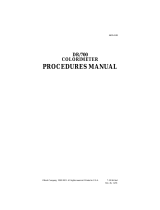Page is loading ...

Bacteria, Iron-related DOC316.53.01325
Visual determination
Semi-quantitative IRB-BART™1
Scope and application: For the determination of iron-related bacteria in brine solutions, produced waters and
hydraulic fracturing waters.
1IRB-BART is a trademark of Droycon Bioconcepts Inc.
Test preparation
Before starting
Do not touch the inner surface of the tube or lid. Keep contamination out of the tube and lid. Use the aseptic technique.
Set the caps on a clean surface with the flat surface down.
Iron-related bacteria (IRB) primarily grows on surfaces and not directly in water. Make sure to get a representative sample.
Review the Safety Data Sheets (MSDS/SDS) for the chemicals that are used. Use the recommended personal protective
equipment.
Dispose of reacted solutions according to local, state and federal regulations. Refer to the Safety Data Sheets for disposal
information for unused reagents. Refer to the environmental, health and safety staff for your facility and/or local regulatory
agencies for further disposal information.
Sterilize the reacted sample before disposal. Refer to Disposal on page 3.
Items to collect
Description Quantity
BART Test for iron-related bacteria (IRB) 1
Refer to Consumables and replacement items on page 4 for order information.
Test procedure
1. Remove the inner tube
from the outer tube.
2. Pour at least 20 mL of
sample in the outer tube.
3. Fill the inner tube to the
fill line with the sample that
is in the outer tube. Tighten
the cap on the inner tube.
Discard the unused sample
in the outer tube.
4. Put the inner tube in the
empty outer tube. Tighten
the cap on the outer tube.
Do not shake or swirl the
tubes after the sample is
added. Let the ball float to
the top with no help.
1

5. Write the date and
sample name on the outer
tube.
6. Keep the tube at room
temperature and away from
direct sunlight for 8 days.
Do not move the tube.
7. Examine the tube each
day. Record the date when
a reaction is first seen.
Refer to Test results
on page 2.
Test results
Presence/Absence
When iron-related bacteria are in the sample, a foam or a brown slime ring forms around
the ball and/or there is a brown slime growth at the bottom of the tube. Refer to Figure 1.
Figure 1 Negative versus positive test results
Negative (absent/non-aggressive) Positive (present/aggressive)
The solution has no foam or brown slime. Foam or a brown slime ring forms around the ball and/or
there is a brown slime growth at the bottom of the tube.
Make an estimate of the bacteria population
If the test result is positive, make an estimate of the bacteria population and the
aggressivity. Refer to Table 1. A faster reaction occurs when the bacteria population is
high.
Table 1 Approximate bacteria population
Days to reaction Approximate IRB population (cfu/mL) Aggressivity
1 570,000 Very high
2 140,000 High
3 35,000 High
4 9000 Moderate
5 2200 Moderate
6 500 Moderate
7 150 Moderate
8 25 Low
2Bacteria, Iron-related, IRB-BART

Advanced test information
If the test result is positive, examine the tubes for dominant bacteria. Refer to Figure 2. If
the dominant bacteria is enteric or pseudomonads and has a high or very high
aggressivity, a fecal coliform test is recommended on a fresh sample to determine if there
is a hygiene risk.
Figure 2 Dominant bacteria
Anaerobic
bacteria
Iron-related bacteria Pseudomonads Enteric
bacteria
Heterotrophic
bacteria
Pseudomonads
and enterics
Foam around
ball
Brown rings, gel and/or clouds Green cloudy Red cloudy Cloudy Black solution
Summary of method
When iron-related bacteria (IRB) are in the sample, a series of reactions occur in the
redox and nutrient gradients that develop in the IRB-BART tube during incubation. The
iron-related bacteria use the nutrients and ferric iron in the tube to grow. The iron-related
bacteria cause foam, clouding, slime and/or color changes.
The bacteria determined in this test include iron oxidizing and reducing bacteria, the
sheathed iron bacteria, Gallionella, pseudomonads and enteric bacteria. These
organisms can cause biofouling problems such as plugging, corrosion, cloudiness and
color.
Disposal
Sterilize the reacted sample before disposal. Refer to Figure 3.
Figure 3 Disposal
Bacteria, Iron-related, IRB-BART 3

Consumables and replacement items
Required reagents
Description Quantity/Test Unit Item no.
BART Test for iron-related bacteria (IRB) 1 9/pkg 2432309
BART Test for iron-related bacteria (IRB) 1 27/pkg 2432327
HACH COMPANY
WORLD HEADQUARTERS
Telephone: (970) 669-3050
FAX: (970) 669-2932
FOR TECHNICAL ASSISTANCE, PRICE INFORMATION AND ORDERING:
Call 800-227-4224
Contact the HACH office or distributor serving you.
www.hach.com [email protected]
In the U.S.A. –
Outside the U.S.A. –
On the Worldwide Web – ; E-mail –
toll-free
© Hach Company/Hach Lange GmbH, 2012–2016. All rights reserved. 07/2016, Edition 3
/









